Flare-On 2019 write-up
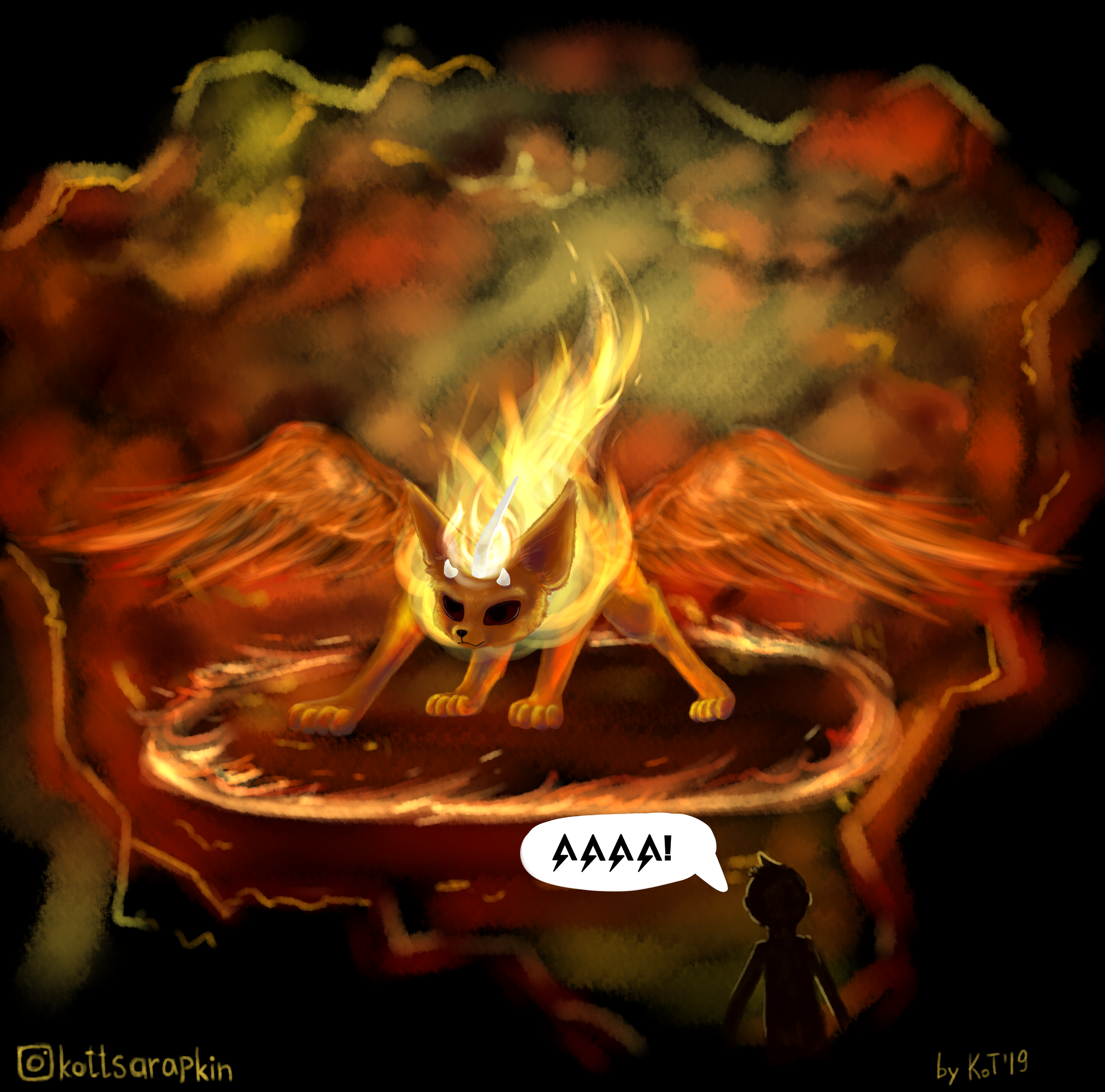
-0x01 - Intro
This article is devoted to the analysis of all the tasks of Flare-On 2019 - the annual competition for reverse engineering from FireEye. I am taking part in these competitions for the second time. In the previous year, I managed to get to 11th place in terms of completion time, having solved all the problems in about 13 days. This year, the set of tasks was easier, and I met in 54 hours, taking at the same time 3 place in terms of delivery.
In this article I tried to describe those moments that aroused my greatest interest, therefore, the analysis will not describe the routine of working in the IDA, understanding the algorithms of each function and other not very interesting points. I hope that after reading this, you will find something new and useful for yourself. You can find the analysis of problems from the authors, as well as some statistics and prizes for the winners here .
If you are interested, then welcome to cat!
0x00 - Contents
- 0x01 - Memecat Battlestation [Shareware Demo Edition]
- 0x02 - Overlong
- 0x03 - Flarebear
- 0x04 - Dnschess
- 0x05 - demo
- 0x06 - bmphide
- 0x07 - wopr
- 0x08 - snake
- 0x09 - reloadered
- 0x0A - Mugatu
- 0x0B - vv_max
- 0x0C - help
- 0x0D - Summary
0x01 - Memecat Battlestation [Shareware Demo Edition]
Welcome to the Sixth Flare-On Challenge!
This is a simple game. Reverse engineer it to figure out what "weapon codes" you need to enter to defeat each of the two enemies and the victory screen will reveal the flag. Enter the flag here on this site to score and move on to the next level.
* This challenge is written in .NET. If you don't already have a favorite .NET reverse engineering tool I recommend dnSpy
** If you already solved the full version of this game at our booth at BlackHat or the subsequent release on twitter, congratulations, enter the flag from the victory screen now to bypass this level.
This task was laid out in advance as part of Black Hat USA 2019, about the same time I decided it. I do not remember how he solved it Task is quite simple, so we will not consider its solution.
0x02 - Overlong
The secret of this next challenge is cleverly hidden. However, with the right approach, finding the solution will not take an overlong amount of time.
Given x86 .exe file. When you try to start, a message is displayed with the following contents:

When analyzing the application, you may find that the message is stored in some encoding with a variable character length (from 1 to 4 bytes). When the decoding function is called, it receives the length of the expected result, which is shorter than the message itself, which is why the flag is not visible. You can fix the length value passed to the function in debug mode and get the full message with the flag:

You could also rewrite the decoding algorithm in Python and get the flag:
msg = [ ... ] # output = [] i = 0 while i < len(msg): if (msg[i] >> 3) == 0x1e: out_char = ( ((msg[i + 3] & 0x3F) << 0 ) | ((msg[i + 2] & 0x3F) << 6 ) | ((msg[i + 1] & 0x3F) << 12) | ((msg[i + 0] & 7) << 18) ) output.append(out_char) i += 4 elif (msg[i] >> 4) == 0x0e: out_char = ( ((msg[i + 2] & 0x3F) << 0 ) | ((msg[i + 1] & 0x3F) << 6 ) | ((msg[i + 0] & 0xF) << 12) ) output.append(out_char) i += 3 elif (msg[i] >> 5) == 6: out_char = ( ((msg[i + 1] & 0x3F) << 0 ) | ((msg[i + 0] & 0xF) << 6 ) ) output.append(out_char) i += 2 else: output.append(msg[i]) i += 1 print(bytes([i for i in output])) # b'I never broke the encoding: I_a_M_t_h_e_e_n_C_o_D_i_n_g@flare-on.com'
0x03 - Flarebear
We at Flare have created our own Tamagotchi pet, the flarebear. He is very fussy. Keep him alive and happy and he will give you the flag.
In this task, an apk
file for Android
. Consider a solution method without starting the application itself.
The first step is to get the source code of the application. To do this, using the dex2jar
utility dex2jar
convert apk
to jar
and then get the Java
source code using the decompiler, which I prefer to use cfr
.
~/retools/d2j/d2j-dex2jar.sh flarebear.apk java -jar ~/retools/cfr/cfr-0.146.jar --outputdir src flarebear-dex2jar.jar
By analyzing the source code of the application, you can find an interesting .danceWithFlag()
method, which is located in the FlareBearActivity.java
file. Inside .danceWithFlag()
, the raw
application resources are decrypted using the .decrypt(String, byte[])
method, the first argument of which is the string obtained using the .getPassword()
method. Surely the flag is in encrypted resources, so let's try to decrypt them. To do this, I decided to rewrite the decompiled code a bit, getting rid of Android
dependencies and leaving only the methods necessary for decryption, so that the resulting code could be compiled. Further, during the analysis, it was found that the .getPassword()
method depends on three integer state values. Each value lies in a small interval from 0
to N
, so you can go through all the possible values in search of the desired password.
The result is the following code:
import java.io.InputStream; import java.nio.charset.Charset; import java.security.Key; import java.security.spec.AlgorithmParameterSpec; import java.security.spec.KeySpec; import java.util.ArrayList; import java.util.Collection; import java.util.HashMap; import java.util.List; import java.util.stream.Collectors; import java.util.Collections; import java.io.*; import javax.crypto.Cipher; import javax.crypto.SecretKey; import javax.crypto.SecretKeyFactory; import javax.crypto.spec.IvParameterSpec; import javax.crypto.spec.PBEKeySpec; import javax.crypto.spec.SecretKeySpec; public final class Main { public static void main (String args []) throws Exception { Main a = new Main(); InputStream inputStream = new FileInputStream("ecstatic"); long fileSize = new File("ecstatic").length(); byte[] file1 = new byte[(int) fileSize]; inputStream.read(file1); inputStream = new FileInputStream("ecstatic2"); fileSize = new File("ecstatic2").length(); byte[] file2 = new byte[(int) fileSize]; inputStream.read(file2); for(int i = 0; i < 9; i++) { for(int j = 0; j < 7; j++) { for(int k = 1; k < 16; k++) { String pass = a.getPassword(i, j, k); try { byte[] out1 = a.decrypt(pass, file1); byte[] out2 = a.decrypt(pass, file2); OutputStream outputStream = new FileOutputStream("out1"); outputStream.write(out1); outputStream = new FileOutputStream("out2"); outputStream.write(out2); System.out.println("yep!"); } catch (javax.crypto.BadPaddingException ex) { } } } } } public final byte[] decrypt(Object object, byte[] arrby) throws Exception { Object object2 = Charset.forName("UTF-8"); object2 = "pawsitive_vibes!".getBytes((Charset)object2); object2 = new IvParameterSpec((byte[])object2); object = ((String)object).toCharArray(); Object object3 = Charset.forName("UTF-8"); object3 = "NaClNaClNaCl".getBytes((Charset)object3); object = new PBEKeySpec((char[])object, (byte[])object3, 1234, 256); object = SecretKeyFactory.getInstance("PBKDF2WithHmacSHA1").generateSecret((KeySpec)object); object3 = new SecretKeySpec(((SecretKey)object).getEncoded(), "AES"); object = Cipher.getInstance("AES/CBC/PKCS5Padding"); ((Cipher)object).init(2, (Key)object3, (AlgorithmParameterSpec)object2); object = ((Cipher)object).doFinal(arrby); return (byte [])object; } public final String getPassword(int n, int n2, int n3) { String string2 = "*"; String string3 = "*"; switch (n % 9) { case 8: { string2 = "*"; break; } case 7: { string2 = "&"; break; } case 6: { string2 = "@"; break; } case 5: { string2 = "#"; break; } case 4: { string2 = "!"; break; } case 3: { string2 = "+"; break; } case 2: { string2 = "$"; break; } case 1: { string2 = "-"; break; } case 0: { string2 = "_"; } } switch (n3 % 7) { case 6: { string3 = "@"; break; } case 4: { string3 = "&"; break; } case 3: { string3 = "#"; break; } case 2: { string3 = "+"; break; } case 1: { string3 = "_"; break; } case 0: { string3 = "$"; } case 5: } String string4 = String.join("", Collections.nCopies(n / n3, "flare")); String string5 = String.join("", Collections.nCopies(n2 * 2, this.rotN("bear", n * n2))); String string6 = String.join("", Collections.nCopies(n3, "yeah")); StringBuilder stringBuilder = new StringBuilder(); stringBuilder.append(string4); stringBuilder.append(string2); stringBuilder.append(string5); stringBuilder.append(string3); stringBuilder.append(string6); return stringBuilder.toString(); } public final String rotN(String charSequence, int n) { Collection<String> collection = new ArrayList(charSequence.length()); for (int i = 0; i < charSequence.length(); ++i) { char c; char c2 = c = charSequence.charAt(i); if (Character.isLowerCase(c)) { char c3; c2 = c3 = (char)(c + n); if (c3 > 'z') { c2 = c3 = (char)(c3 - n * 2); } } collection.add(Character.valueOf(c2).toString()); } return collection.stream().collect(Collectors.joining()); // return ArraysKt.joinToString$default(CollectionsKt.toCharArray((List)collection), (CharSequence)FLARE_BEAR_NAME, null, null, 0, null, null, 62, null); } }
We will extract the encrypted resources, compile and run the resulting file:
$ ~/retools/apktool/apktool d flarebear.apk $ cp flarebear/res/raw/* . $ javac Main.java $ java Main
Fortunately, only one password is valid out of all the selected password options. As a result, we get two images with a flag:
~/flareon2019/3 - Flarebear$ file out* out1: PNG image data, 2100 x 2310, 8-bit/color RGB, non-interlaced out2: PNG image data, 2100 x 2310, 8-bit/color RGB, non-interlaced


0x04 - Dnschess
Some suspicious network traffic led us to this unauthorized chess program running on an Ubuntu desktop. This appears to be the work of cyberspace computer hackers. You'll need to make the right moves to solve this one. Good luck!
This task contains a traffic dump, an ELF
executable file ChessUI
and a library ChessAI.so
. By running the executable file, you can see the chessboard.
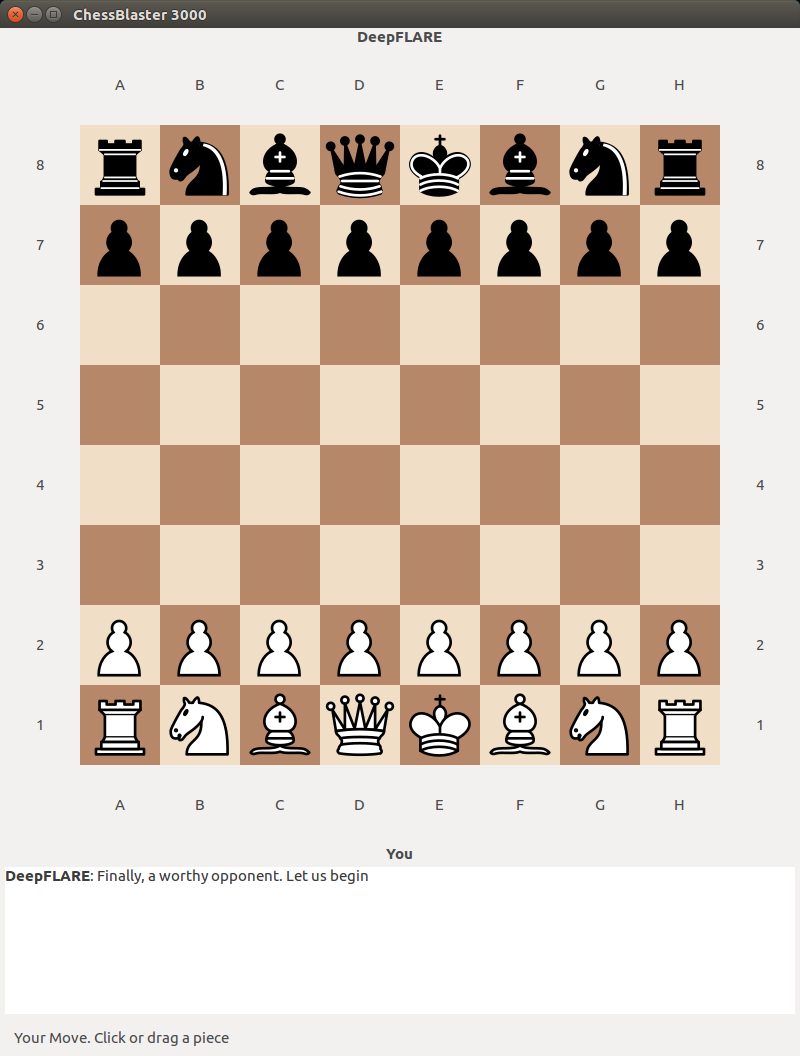
Let's start the analysis with a traffic dump.

All traffic consists of queries to a Type A
DNS
server. The queries themselves consist of the names of the pieces, the description of the move in the chess game and the constant part of .game-of-thrones.flare-on.com
, for example rook-c3-c6.game-of-thrones.flare-on.com
. By the constant part, you can easily find the right place in the ChessAI.so
library:
signed __int64 __fastcall getNextMove(int idx, const char *chess_name, unsigned int pos_from, unsigned int pos_to, \__int64 a5) { struct hostent *v9; // [rsp+20h] [rbp-60h] char *ip_addr; // [rsp+28h] [rbp-58h] char dns_name; // [rsp+30h] [rbp-50h] unsigned __int64 v12; // [rsp+78h] [rbp-8h] v12 = __readfsqword(0x28u); strcpy(&dns_name, chess_name); pos_to_str(&dns_name, pos_from); pos_to_str(&dns_name, pos_to); strcat(&dns_name, ".game-of-thrones.flare-on.com"); v9 = gethostbyname(&dns_name); if ( !v9 ) return 2LL; ip_addr = *v9->h_addr_list; if ( *ip_addr != 127 || ip_addr[3] & 1 || idx != (ip_addr[2] & 0xF) ) return 2LL; sleep(1u); flag[2 * idx] = ip_addr[1] ^ key[2 * idx]; flag[2 * idx + 1] = ip_addr[1] ^ key[2 * idx + 1]; *(_DWORD *)a5 = (unsigned __int8)ip_addr[2] >> 4; *(_DWORD *)(a5 + 4) = (unsigned __int8)ip_addr[3] >> 1; strcpy((char *)(a5 + 8), off_4120[idx]); return (unsigned __int8)ip_addr[3] >> 7; }
It can be seen from the code that based on the received ip
addresses, a certain byte string is decrypted, which is stored in another memory area, which I called flag
.
To solve the task, the first thing to do is get all the ip
addresses from the traffic dump. You can do this with the following command:
tshark -r capture.pcap | grep -P -o '127.(\d+).(\d+).(\d+)' | grep -v '127.0.0.1'
ips
saving all the ip
addresses to the ips
file, ips
can use the following Python
code to get the flag:
with open('ips') as f: ips = f.read().split() flag = bytearray(64) key = b'yZ\xb8\xbc\xec\xd3\xdf\xdd\x99\xa5\xb6\xac\x156\x85\x8d\t\x08wRMqT}\xa7\xa7\x08\x16\xfd\xd7' for ip in ips: a, b, c, d = map(int, ip.split('.')) if d & 1: continue idx = c & 0xf if idx > 14: continue flag[2*idx] = b ^ key[2*idx] flag[2*idx + 1] = b ^ key[2*idx + 1] print(flag.decode() + '@flare-on.com') # LooksLikeYouLockedUpTheLookupZ@flare-on.com
0x05 - demo
Someone on the Flare team tried to impress us with their demoscene skills. It seems blank. See if you can figure it out or maybe we will have to fire them. No pressure.
Given the executable file 4k.exe
, which uses DirectX
. When launched, the rotating FlareOn
logo is displayed in the main window.

Static analysis of the program reveals a single function, which is the entry point. In content, the function resembles the implementation of code decryption. We will not waste time analyzing the algorithm of this function, just put a breakpoint on the ret
instruction and see where control is transferred. After returning, we find 0x00420000
at the address 0x00420000
, the code at which is disassembled as something adequate:
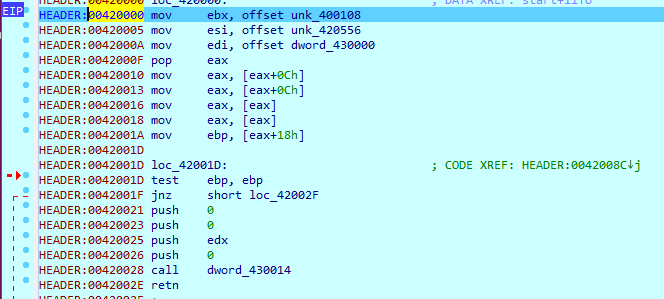
Next, it was decided to transfer this code from debug mode to the IDA
database using the API
and continue static analysis.
The new code at the beginning imports the necessary functions from various libraries. The table of these functions can also be restored in dynamics. The result is the following set of functions:
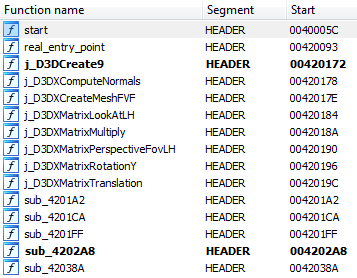
The "real" entry point to the program will be:

Note the creation of DeviceInterface
type IDirect3DDevice9 **
. In the future, this interface is actively used, and to simplify the reverse, it is necessary to determine the table of its methods. It was possible to quickly find the definition of the interface, for example, here . I parsed this table and converted it to a structure for the IDA
. Applying the resulting type to DeviceInterface
can significantly simplify further code analysis. The following screenshots show the result of the decompiler for the main function of the scene rendering cycle before and after applying the type.


Upon further analysis, it was found that two polygonal meshes (mesh, polygon mesh) are created in the program, although when the program is running we see only one object. Also, when building grids, their vertices are encrypted using XOR
, which also raises suspicions. Let's decipher and visualize the vertices. The second grid is of most interest, since it has significantly more vertices. matplotlib
all the vertices, I found that the Z
coordinate of each of them is 0, so for visualization it was decided to draw two-dimensional graphs using matplotlib
. The following code and result with a flag turned out:
import struct import matplotlib.pyplot as plt with open('vertexes', 'rb') as f: data = f.read() n = len(data) // 4 data = list(struct.unpack('{}I'.format(n), data)) key = [0xCB343C8, 0x867B81F0, 0x84AF72C3] data = [data[i] ^ key[i % 3] for i in range(len(data))] data = struct.pack('{}I'.format(n), *data) data = list(struct.unpack('{}f'.format(n), data)) x = data[0::3] y = data[1::3] z = data[2::3] print(z) plt.plot(x, y) plt.show()

0x06 - bmphide
Tyler Dean hiked up Mt. Elbert (Colorado's tallest mountain) at 2am to capture this picture at the perfect time. Never skip leg day. We found this picture and executable on a thumb drive he left at the trail head. Can he be trusted?
In task, the executable file bmphide.exe
and the image.bmp
image are image.bmp
. It can be assumed that some message is hidden in the image using steganography methods.
The binary is written in C#
, so I used the dnSpy
utility for analysis. You can immediately notice that most of the names of the methods are obfuscated. If you look at the Program.Main
method, you can understand the logic of the program and make assumptions about the purpose of some of them:
// BMPHIDE.Program // Token: 0x06000018 RID: 24 RVA: 0x00002C18 File Offset: 0x00002C18 private static void Main(string[] args) { Program.Init(); Program.yy += 18; string filename = args[2]; string fullPath = Path.GetFullPath(args[0]); string fullPath2 = Path.GetFullPath(args[1]); byte[] data = File.ReadAllBytes(fullPath2); Bitmap bitmap = new Bitmap(fullPath); byte[] data2 = Program.h(data); Program.i(bitmap, data2); bitmap.Save(filename); }
- The application is initialized using the
Program.Init()
method - Read data file and image file
- Using the
byte [] Program.h(byte [])
method, some data conversion is performed - Using the
Program.i(Bitmap, byte[])
methodProgram.i(Bitmap, byte[])
, the converted data is inserted into the image - The resulting image is saved with a new name.
During application initialization, various class A
methods are called. A superficial analysis of the class showed the similarity of some of its methods with the methods of the obfuscator ConfuserEx
(file AntiTamper.JIT.cs
). The application is really protected from debugging. In this case, it was not possible to remove the protective mechanisms using the de4dot
utility and its forks, so it was decided to continue the analysis.
Consider the Program.i
method, which is used to insert data into an image.
public static void i(Bitmap bm, byte[] data) { int num = Program.j(103); for (int i = Program.j(103); i < bm.Width; i++) { for (int j = Program.j(103); j < bm.Height; j++) { bool flag = num > data.Length - Program.j(231); if (flag) { break; } Color pixel = bm.GetPixel(i, j); int red = ((int)pixel.R & Program.j(27)) | ((int)data[num] & Program.j(228)); int green = ((int)pixel.G & Program.j(27)) | (data[num] >> Program.j(230) & Program.j(228)); int blue = ((int)pixel.B & Program.j(25)) | (data[num] >> Program.j(100) & Program.j(230)); Color color = Color.FromArgb(Program.j(103), red, green, blue); bm.SetPixel(i, j, color); num += Program.j(231); } } }
Very similar to the classic LSB
, however, in places where constants are expected, the int Program.j(byte)
method is used. The result of its work depends on various global values obtained, including during initialization in the Program.Init()
method. It was decided not to reverse his work, but to get all possible values at runtime. dnSpy
allows dnSpy
to edit decompiled application code and save modified modules. We take advantage of this and rewrite the Program.Main
method as follows:
private static void Main(string[] args) { Program.Init(); Program.yy += 18; for (int i = 0; i < 256; i++) { Console.WriteLine(string.Format("j({0}) = {1}", i, Program.j((byte)i))); } }
At startup, we get the following values:
E:\>bmphide_j.exe j(0) = 206 j(1) = 204 j(2) = 202 j(3) = 200 j(4) = 198 j(5) = 196 j(6) = 194 j(7) = 192 j(8) = 222 j(9) = 220 j(10) = 218 j(11) = 216 j(12) = 214 j(13) = 212 j(14) = 210 j(15) = 208 j(16) = 238 j(17) = 236 j(18) = 234 j(19) = 232 j(20) = 230 ...
Replace the calls to Program.j
in the Program.j
method with the resulting constants:
public static void i(Bitmap bm, byte[] data) { int num = 0; for (int i = 0; i < bm.Width; i++) { for (int j = 0; j < bm.Height; j++) { bool flag = num > data.Length - 1; if (flag) { break; } Color pixel = bm.GetPixel(i, j); int red = ((int)pixel.R & 0xf8) | ((int)data[num] & 0x7); int green = ((int)pixel.G & 0xf8) | (data[num] >> 3 & 0x7); int blue = ((int)pixel.B & 0xfc) | (data[num] >> 6 & 0x3); Color color = Color.FromArgb(0, red, green, blue); bm.SetPixel(i, j, color); num += 1; } } }
Now it becomes clear how to insert each byte of the message into the image:
- bits 0 through 2 are placed in the 3 LSBs of the point's red channel
- bits 3 through 5 are placed in the 3 LSBs of the point's green channel
- bits 6 to 7 are placed in the 2 LSBs of the point's blue channel
Next, I tried to repeat the algorithm of the data conversion method, but the calculation result did not match the output of the program. As it turned out, class A
also has functionality for replacing methods (in A.VerifySignature(MethodInfo m1, MethodInfo m2)
) and modifying IL
of the method byte code (in A.IncrementMaxStack
).
To select the methods that need to be replaced in Program
, in Program.Init
, the bytecode IL
of all methods is hashed and compared with pre-calculated values. In total, two methods are replaced. To find out which ones, run the application under the debugger by setting breakpoints on A.VerifySignature
calls, and you must skip the call A.CalculateStack()
in Program.Init
, because It prevents debugging.

As a result, you can see that the Program.a
method is replaced by Program.b
, and Program.c
is replaced by Program.d
.
Now you need to deal with the modification of the bytecode:
private unsafe static uint IncrementMaxStack(IntPtr self, A.ICorJitInfo* comp, A.CORINFO_METHOD_INFO* info, uint flags, byte** nativeEntry, uint* nativeSizeOfCode) { bool flag = info != null; if (flag) { MethodBase methodBase = Ac(info->ftn); bool flag2 = methodBase != null; if (flag2) { bool flag3 = methodBase.MetadataToken == 100663317; if (flag3) { uint flNewProtect; A.VirtualProtect((IntPtr)((void*)info->ILCode), info->ILCodeSize, 4u, out flNewProtect); Marshal.WriteByte((IntPtr)((void*)info->ILCode), 23, 20); Marshal.WriteByte((IntPtr)((void*)info->ILCode), 62, 20); A.VirtualProtect((IntPtr)((void*)info->ILCode), info->ILCodeSize, flNewProtect, out flNewProtect); } else { bool flag4 = methodBase.MetadataToken == 100663316; if (flag4) { uint flNewProtect2; A.VirtualProtect((IntPtr)((void*)info->ILCode), info->ILCodeSize, 4u, out flNewProtect2); Marshal.WriteInt32((IntPtr)((void*)info->ILCode), 6, 309030853); Marshal.WriteInt32((IntPtr)((void*)info->ILCode), 18, 209897853); A.VirtualProtect((IntPtr)((void*)info->ILCode), info->ILCodeSize, flNewProtect2, out flNewProtect2); } } } } return A.originalDelegate(self, comp, info, flags, nativeEntry, nativeSizeOfCode); }
It is clear that methods with specific MetadataToken
values, namely 0x6000015
and 0x6000014
, will be modified. These tokens correspond to the methods Program.h
and Program.g
. dnSpy
has a built-in hex
editor, in which, when hovering, the method data is highlighted: their title (highlighted in purple) and byte code (highlighted in red), as shown in the screenshot. You can go to the desired method in the hex
editor by clicking on the corresponding address in the comment before the decompiled method (for example, File Offset: 0x00002924
).
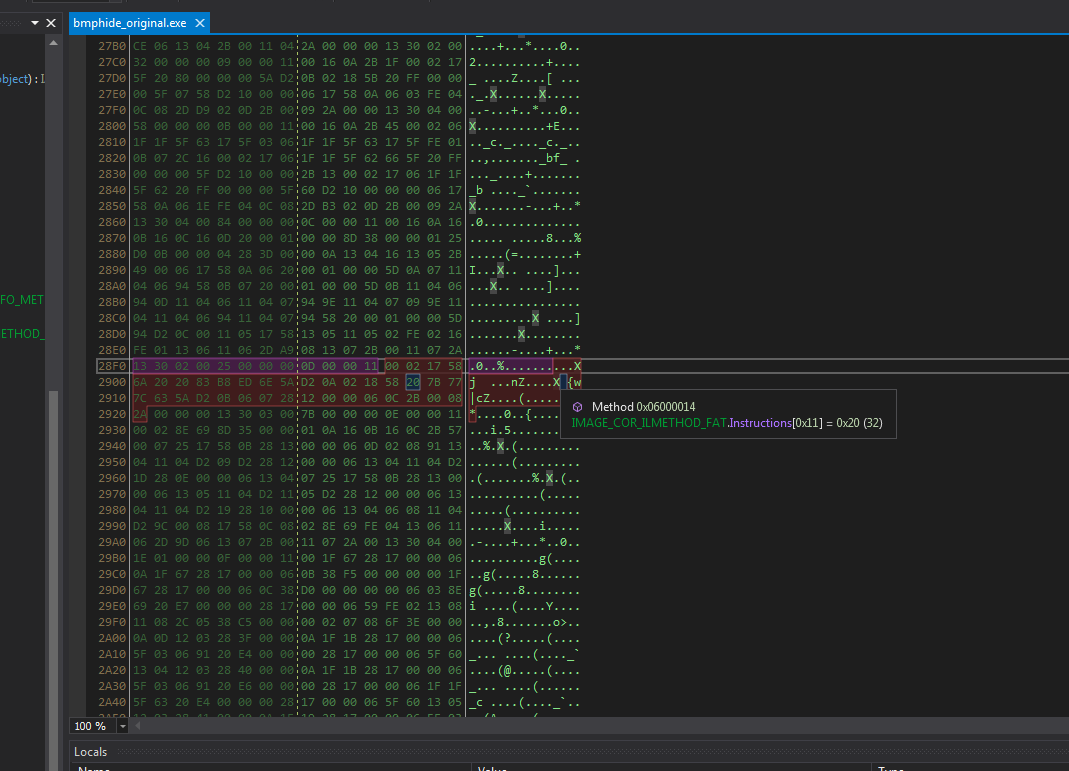
Let's try to apply all the modifications described: we will create a copy of the file, in any hex editor we will change the values at the required offsets, which we learned from dnSpy
and we will replace the a -> b
and c -> d
methods in Program.h
. We also remove from Program.Init
all calls to module A
If everything is done correctly, then when we try to insert some message into the picture using the modified application, we will get the same result as when the original application was working. The screenshots below show the decompiled code of the methods of the original and modified applications.


It remains to create an inverse transformation algorithm. It is quite simple, so I will give only the resulting Python
script:
from PIL import Image # Rotate left: 0b1001 --> 0b0011 rol = lambda val, r_bits, max_bits: \ (val << r_bits%max_bits) & (2**max_bits-1) | \ ((val & (2**max_bits-1)) >> (max_bits-(r_bits%max_bits))) # Rotate right: 0b1001 --> 0b1100 ror = lambda val, r_bits, max_bits: \ ((val & (2**max_bits-1)) >> r_bits%max_bits) | \ (val << (max_bits-(r_bits%max_bits)) & (2**max_bits-1)) rol8 = lambda a, b: rol(a, b, 8) ror8 = lambda a, b: ror(a, b, 8) def extract(fname): img = Image.open(fname) w, h = img.size result = bytearray() for i in range(w): for j in range(h): r, g, b = img.getpixel((i, j)) # print('{:02x} {:02x} {:02x}'.format(r, g, b)) byte = (r & 0b111) | ((g & 0b111) << 3) | ((b & 0b11) << 6) result.append(byte) return result enc = extract('image.bmp') n = len(enc) dec = bytearray() def g(idx): b = ((idx + 1) * 309030853) & 0xff k = ((idx + 2) * 209897853) & 0xff return b ^ k j = 0 for i in range(n): x = enc[i] x = rol8(x, 3) x ^= g(2*i + 1) x = ror8(x, 7) x ^= g(2*i + 0) dec.append(x) with open('output', 'wb') as f: f.write(dec)
By running this script, we get another bmp
image without a flag. Repeating the procedure on it, we get the final image with the flag.

0x07 - wopr
We used our own computer hacking skills to "find" this AI on a military supercomputer. It does strongly resemble the classic 1983 movie WarGames. Perhaps life imitates art? If you can find the launch codes for us, we'll let you pass to the next challenge. We promise not to start a thermonuclear war.
In task the console application worp.exe
. Apparently, to solve it, you need to pick up some code.
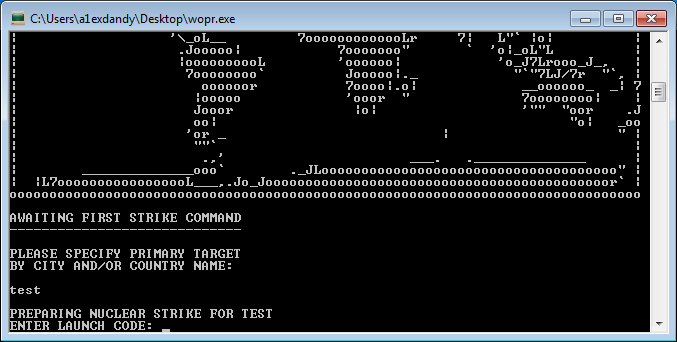
Analysis of the entry point shows that this is a self-extracting archive. At startup, the environment variable _MEIPASS2
. If this variable does not exist, a temporary directory is created into which the contents of the archive are unpacked, and the application starts once more with the given environment variable _MEIPASS2
. Archive Content:
. ├── api-ms-win-core-console-l1-1-0.dll ├── ... ├── ... ├── api-ms-win-crt-utility-l1-1-0.dll ├── base_library.zip ├── _bz2.pyd ├── _ctypes.pyd ├── _hashlib.pyd ├── libcrypto-1_1.dll ├── libssl-1_1.dll ├── _lzma.pyd ├── pyexpat.pyd ├── python37.dll ├── select.pyd ├── _socket.pyd ├── _ssl.pyd ├── this │ ├── __init__.py │ └── key ├── ucrtbase.dll ├── unicodedata.pyd ├── VCRUNTIME140.dll └── wopr.exe.manifest 1 directory, 56 files
Judging by the content, we are dealing with a Python
application packaged in exe
. In support of this, in the main binary you can find dynamic import of the corresponding functions of the Python
library: PyMarshal_ReadObjectFromString
, PyEval_EvalCode
and others. For further analysis, you need to extract Python
bytecode. To do this, save the contents of the archive from the temporary directory and _MEIPASS2
path to it in the environment variable _MEIPASS2
. Run the main binary in debug mode by setting a breakpoint on the PyMarshal_ReadObjectFromString
function. This function takes as arguments a pointer to a buffer with a serialized Python
code and its length. We dump the contents of the buffer of known length for each of the calls. I got only 2 calls, while in the second the serialized object is much larger, and we will analyze it.
A fairly simple way to analyze the obtained data is to convert it to the format of .pyc
files (compiled Python
bytecode) and decompilation using uncompyle6
. To do this, it is enough to add a 16-byte header to the received data. As a result, I got the following file:
00000000: 42 0d 0d 0a 00 00 00 00 de cd 57 5d 00 00 00 00 B.........W].... 00000010: e3 00 00 00 00 00 00 00 00 00 00 00 00 09 00 00 ................ 00000020: 00 40 00 00 00 73 3c 01 00 00 64 00 5a 00 64 01 .@...s<...dZd 00000030: 64 02 6c 01 5a 01 64 01 64 02 6c 02 5a 02 64 01 dlZddlZd
Next, we decompile the resulting file using uncompyle6
:
uncompyle6 task.pyc > task.py
If we try to run the decompiled file, we will get an exception in the line BOUNCE = pkgutil.get_data('this', 'key')
. This can be easily fixed by simply assigning the contents of the key
file from the archive to the BOUNCE
variable. Re-running the script, we will see only the inscription LOADING...
Apparently, some techniques are used in the task that prevent decompilation. Let's analyze the resulting Python
code. At the very end, we see the following cycle:
for i in range(256): try: print(lzma.decompress(fire(eye(__doc__.encode()), bytes([i]) + BOUNCE))) except Exception: pass
You can understand that the print
function is actually overridden as exec
, and its argument depends only on __doc__.encode()
- the text at the beginning of the file. print
print
try-except
. . , __doc__
. __doc__
:
import marshal with open('pycode1', 'rb') as inp: data = inp.read() code = marshal.loads(data) doc = code.co_consts[0] with open('doc.txt', 'w') as outp: outp.write(doc)
, __doc__
. , i
, . . wrong
:
trust = windll.kernel32.GetModuleHandleW(None)
, . 0x100000
wrong
, . , .
. z3
:
from z3 import * from stage2 import wrong xor = [212, 162, 242, 218, 101, 109, 50, 31, 125, 112, 249, 83, 55, 187, 131, 206] h = list(wrong()) h = [h[i] ^ xor[i] for i in range(16)] b = 16 * [None] x = [] for i in range(16): x.append(BitVec('x' + str(i), 32)) b[0] = x[2] ^ x[3] ^ x[4] ^ x[8] ^ x[11] ^ x[14] b[1] = x[0] ^ x[1] ^ x[8] ^ x[11] ^ x[13] ^ x[14] b[2] = x[0] ^ x[1] ^ x[2] ^ x[4] ^ x[5] ^ x[8] ^ x[9] ^ x[10] ^ x[13] ^ x[14] ^ x[15] b[3] = x[5] ^ x[6] ^ x[8] ^ x[9] ^ x[10] ^ x[12] ^ x[15] b[4] = x[1] ^ x[6] ^ x[7] ^ x[8] ^ x[12] ^ x[13] ^ x[14] ^ x[15] b[5] = x[0] ^ x[4] ^ x[7] ^ x[8] ^ x[9] ^ x[10] ^ x[12] ^ x[13] ^ x[14] ^ x[15] b[6] = x[1] ^ x[3] ^ x[7] ^ x[9] ^ x[10] ^ x[11] ^ x[12] ^ x[13] ^ x[15] b[7] = x[0] ^ x[1] ^ x[2] ^ x[3] ^ x[4] ^ x[8] ^ x[10] ^ x[11] ^ x[14] b[8] = x[1] ^ x[2] ^ x[3] ^ x[5] ^ x[9] ^ x[10] ^ x[11] ^ x[12] b[9] = x[6] ^ x[7] ^ x[8] ^ x[10] ^ x[11] ^ x[12] ^ x[15] b[10] = x[0] ^ x[3] ^ x[4] ^ x[7] ^ x[8] ^ x[10] ^ x[11] ^ x[12] ^ x[13] ^ x[14] ^ x[15] b[11] = x[0] ^ x[2] ^ x[4] ^ x[6] ^ x[13] b[12] = x[0] ^ x[3] ^ x[6] ^ x[7] ^ x[10] ^ x[12] ^ x[15] b[13] = x[2] ^ x[3] ^ x[4] ^ x[5] ^ x[6] ^ x[7] ^ x[11] ^ x[12] ^ x[13] ^ x[14] b[14] = x[1] ^ x[2] ^ x[3] ^ x[5] ^ x[7] ^ x[11] ^ x[13] ^ x[14] ^ x[15] b[15] = x[1] ^ x[3] ^ x[5] ^ x[9] ^ x[10] ^ x[11] ^ x[13] ^ x[15] solver = Solver() for i in range(16): solver.add(x[i] < 128) for i in range(16): solver.add(b[i] == h[i]) if solver.check() == sat: m = solver.model() print(bytes([m[i].as_long() for i in x])) else: print('unsat')
, : 5C0G7TY2LWI2YXMB

0x08 — snake
The Flare team is attempting to pivot to full-time twitch streaming video games instead of reverse engineering computer software all day. We wrote our own classic NES game to stream content that nobody else has seen and watch those subscribers flow in. It turned out to be too hard for us to beat so we gave up. See if you can beat it and capture the internet points that we failed to collect.
NES
- . FCEUX
, .. . , .
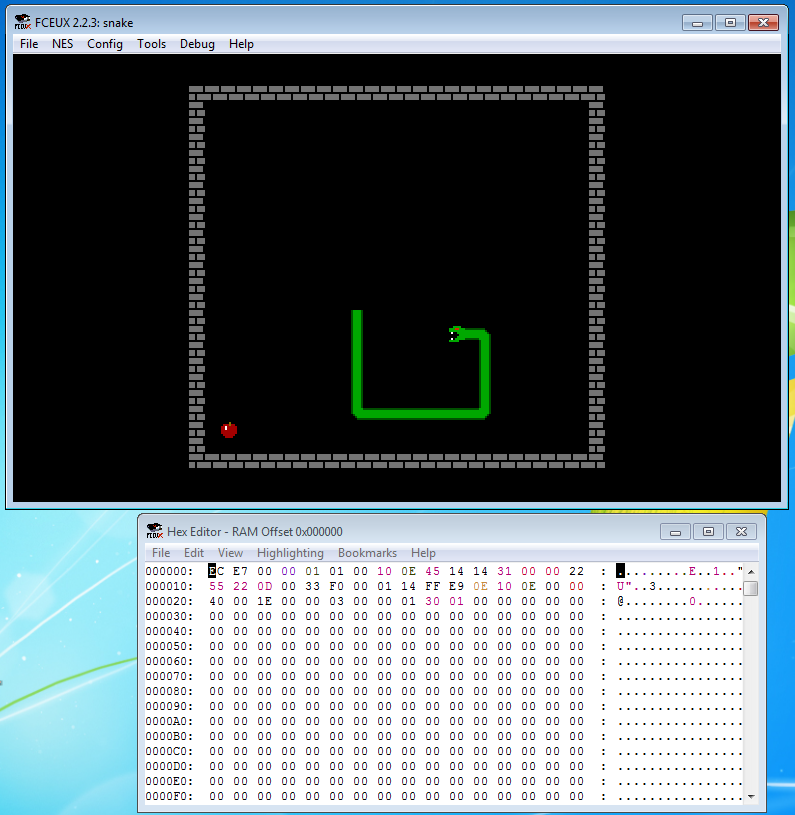
, , 0x25
. , . NES
- IDA
. inesldr . 0x25
. C82A
, . 0x33
.

, — 0x32
0x25
. , . , FCEUX
. .
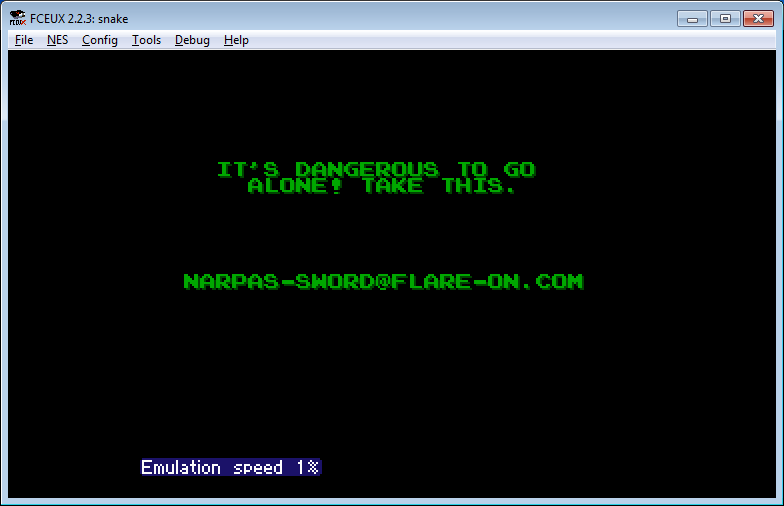
0x09 — reloadered
This is a simple challenge, enter the password, receive the key. I hear that it caused problems when trying to analyze it with ghidra. Remember that valid flare-on flags will always end with @flare-on.com
reloaderd.exe
, . , , . , , XOR
, @FLAG.com
, .
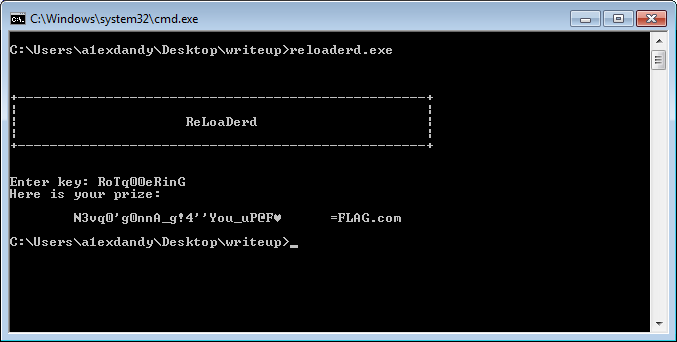
, NOP
. , , . . , . , , . , , NOP
, .
, , XOR
, . @flare-on.com
, . :
flag = bytearray(b'D)6\n)\x0f\x05\x1be&\x10\x04+h0/\x003/\x05\x1a\x1f\x0f8\x02\x18B\x023\x1a(\x04*G?\x04&dfM\x107>(>w\x1c?~64*\x00') for i in range(0x539): for j in range(0x34): if (i % 3) == 0 or (i % 7) == 0: flag[j] ^= (i & 0xff) end = b'@flare-on.com' def xor(a, b): return bytes([i^j for i, j in zip(a, b)]) for i in range(len(flag)): print(i, xor(end, flag[i:])) print(xor(flag, b'3HeadedMonkey'*4))

0x0A — Mugatu
Hello
I'm working an incident response case for Derek Zoolander. He clicked a link and was infected with MugatuWare! As a result, his new headshot compilation GIF was encrypted.
To secure an upcoming runway show, Derek needs this GIF decrypted; however, he refuses to pay the ransom.
We received an additional encrypted GIF from an anonymous informant. The informant told us the GIF should help in our decryption efforts, but we were unable to figure it out.
We're reaching out to you, our best malware analyst, in hopes that you can reverse engineer this malware and decrypt Derek's GIF.
I've included a directory full of files containing:
- MugatuWare malware
- Ransom note (GIFtToDerek.txt)
- Encrypted headshot GIF (best.gif.Mugatu)
- Encrypted informant GIF (the_key_to_success_0000.gif.Mugatu)
Thanks,
Roy
:
- best.gif.Mugatu
- GIFtToDerek.txt
- Mugatuware.exe
- the_key_to_success_0000.gif.Mugatu
, , GIF
-. , .Mugatu
. Mugatuware.exe
. , — . , , .
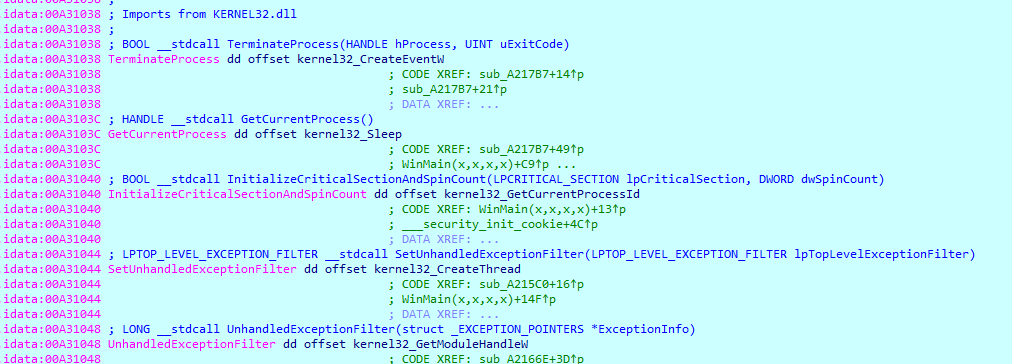
IDA
, :
import ida_segment import ida_name import ida_bytes import ida_typeinf idata = ida_segment.get_segm_by_name('.idata') type_map = {} for addr in range(idata.start_ea, idata.end_ea, 4): name = ida_name.get_name(addr) if name: tp = ida_typeinf.idc_get_type(addr) if tp: type_map[name] = tp for addr in range(idata.start_ea, idata.end_ea, 4): imp = ida_bytes.get_dword(addr) if imp != 0: imp_name = ida_name.get_name(imp) name_part = imp_name.split('_')[-1] ida_name.set_name(addr, name_part + '_imp') if name_part in type_map: tp = type_map[name_part] ida_typeinf.apply_decl(addr, tp.replace('(', 'func(') + ';')
:
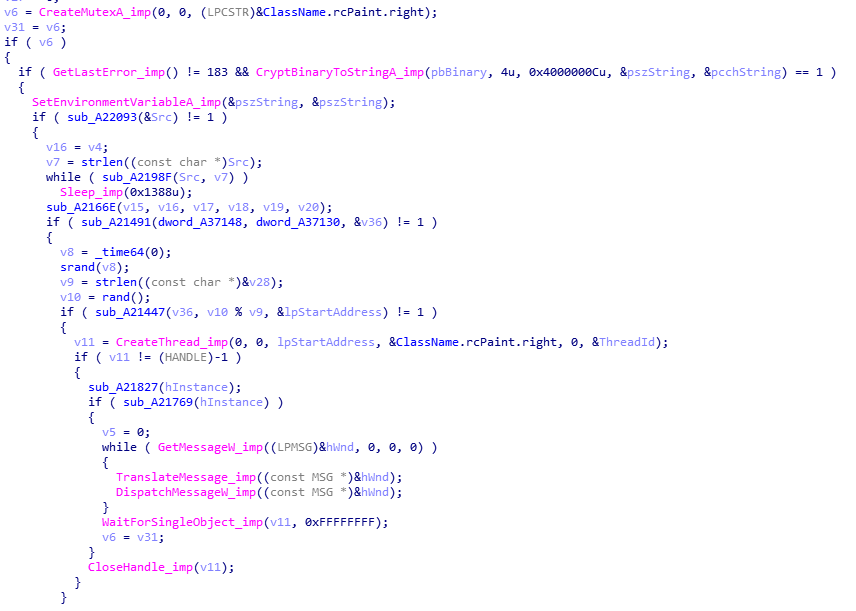
, , in-memory
PE
-. , CrazyPills!!!
. , . Sleep
, http
-. , , , . , , , . .
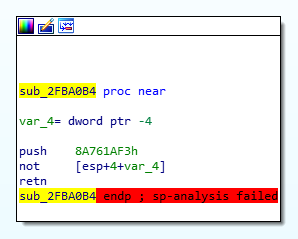
- :
- ;
- ;
-
Mailslots
; -
really, really, really, ridiculously good looking gifs
; -
.gif
..Mugatu
.GIFtToDerek.txt
.
, — 8 . XOR
CrazyPills!!!
, . , :
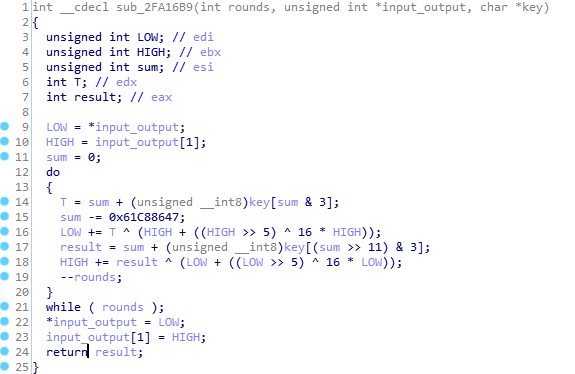
XTEA
, — BYTE
, DWORD
. . Python
:
def crypt(a, b, key): i = 0 for _ in range(32): t = (i + key[i & 3]) & 0xffffffff a = (a + (t ^ (b + ((b >> 5) ^ (b << 4))))) & 0xffffffff i = (0x100000000 + i - 0x61C88647) & 0xffffffff t = (i + key[(i >> 11) & 3]) & 0xffffffff b = (b + (t ^ (a + ((a >> 5) ^ (a << 4))))) & 0xffffffff return a, b def decrypt(a, b, key): i = 0xc6ef3720 for _ in range(32): t = (i + key[(i >> 11) & 3]) & 0xffffffff b = (0x100000000 + b - (t ^ (a + ((a >> 5) ^ (a << 4))))) & 0xffffffff i = (i + 0x61C88647) & 0xffffffff t = (i + key[i & 3]) & 0xffffffff a = (0x100000000 + a - (t ^ (b + ((b >> 5) ^ (b << 4))))) & 0xffffffff return a, b
, the_key_to_success_0000.gif.Mugatu
. , . :

, , . C
. GIF
-.
#include <stdio.h> #include <unistd.h> void decrypt(unsigned int * inp, unsigned int * outp, unsigned char * key) { unsigned int i = 0xc6ef3720; unsigned int a = inp[0]; unsigned int b = inp[1]; unsigned int t; for(int j = 0; j < 32; j++) { t = i + key[(i >> 11) & 3]; b -= t ^ (a + ((a >> 5) ^ (a << 4))); i += 0x61C88647; t = i + key[i & 3]; a -= t ^ (b + ((b >> 5) ^ (b << 4))); } outp[0] = a; outp[1] = b; } int main() { int fd = open("best.gif.Mugatu", 0); unsigned int inp[2]; unsigned int outp[2]; unsigned int key = 0; read(fd, inp, 8); close(fd); for(unsigned long long key = 0; key < 0x100000000; key++) { if((key & 0xffffff) == 0) { printf("%lf\n", ((double)key) / ((double)0x100000000) * 100.0); } decrypt(inp, outp, &key); if( ((char *)outp)[0] == 'G' && ((char *)outp)[1] == 'I' && ((char *)outp)[2] == 'F' && ((char *)outp)[5] == 'a') { printf("%#llx\n", key); } } }
0xb1357331
:

0x0B — vv_max
Hey, at least its not subleq.
vv_max.exe
, . 256- . AVX2
, vpermd
, vpslld
. - :
0000 clear_regs 0001 r0 = 393130324552414c46 0023 r1 = 3030303030303030303030303030303030303030303030303030303030303030 0045 r3 = 1a1b1b1b1a13111111111111111111151a1b1b1b1a1311111111111111111115 0067 r4 = 1010101010101010080408040201101010101010101010100804080402011010 0089 r5 = b9b9bfbf041310000000000000000000b9b9bfbf04131000 00ab r6 = 2f2f2f2f2f2f2f2f2f2f2f2f2f2f2f2f2f2f2f2f2f2f2f2f2f2f2f2f2f2f2f2f 00cd r10 = 140014001400140014001400140014001400140014001400140014001400140 00ef r11 = 1100000011000000110000001100000011000000110000001100000011000 0111 r12 = ffffffff0c0d0e08090a040506000102ffffffff0c0d0e08090a040506000102 0133 r13 = ffffffffffffffff000000060000000500000004000000020000000100000000 0155 r16 = ffffffffffffffffffffffffffffffffffffffffffffffffffffffffffffffff 0177 r17 = 6a09e667bb67ae853c6ef372a54ff53a510e527f9b05688c1f83d9ab5be0cd19 0199 r18 = 428a2f9871374491b5c0fbcfe9b5dba53956c25b59f111f1923f82a4ab1c5ed5 01bb r19 = 300000002000000010000000000000007000000060000000500000004 01dd r20 = 0 01ff r21 = 100000001000000010000000100000001000000010000000100000001 0221 r22 = 200000002000000020000000200000002000000020000000200000002 0243 r23 = 300000003000000030000000300000003000000030000000300000003 0265 r24 = 400000004000000040000000400000004000000040000000400000004 0287 r25 = 500000005000000050000000500000005000000050000000500000005 02a9 r26 = 600000006000000060000000600000006000000060000000600000006 02cb r27 = 700000007000000070000000700000007000000070000000700000007 02ed r20 = vpermd(r0, r20) 02f1 r21 = vpermd(r0, r21) 02f5 r22 = vpermd(r0, r22) 02f9 r23 = vpermd(r0, r23) 02fd r24 = vpermd(r0, r24) 0301 r25 = vpermd(r0, r25) 0305 r26 = vpermd(r0, r26) 0309 r27 = vpermd(r0, r27) 030d r7 = vpsrld(r1, 4) 0311 r28 = r20 ^ r21 0315 r28 = r28 ^ r22 0319 r28 = r28 ^ r23 031d r28 = r28 ^ r24 0321 r28 = r28 ^ r25 0325 r28 = r28 ^ r26 0329 r28 = r28 ^ r27 032d r7 = r7 & r6 0331 r29 = vpslld(r17, 7) 0335 r30 = vpsrld(r17, 25) 0339 r15 = r29 | r30 033d r8 = vpcmpeqb(r1, r6) 0341 r29 = vpslld(r17, 21) 0345 r30 = vpsrld(r17, 11) 0349 r29 = r29 | r30 034d r15 = r15 ^ r29 0351 r8 = vpcmpeqb(r1, r6) 0355 r29 = vpslld(r17, 26) 0359 r30 = vpsrld(r17, 6) 035d r29 = r29 | r30 0361 r15 = r15 ^ r29 0365 r29 = r20 ^ r16 0369 r30 = r20 & r18 036d r29 = r29 ^ r30 0371 r15 = add_d(r29, r15) 0375 r20 = add_d(r15, r0) 0379 r7 = add_b(r8, r7) 037d r29 = r20 ^ r28 0381 r17 = vpermd(r29, r19) 0385 r7 = vpshufb(r5, r7) 0389 r29 = vpslld(r17, 7) 038d r30 = vpsrld(r17, 25) 0391 r15 = r29 | r30 0395 r29 = vpslld(r17, 21) 0399 r30 = vpsrld(r17, 11) 039d r29 = r29 | r30 03a1 r15 = r15 ^ r29 03a5 r29 = vpslld(r17, 26) 03a9 r30 = vpsrld(r17, 6) 03ad r29 = r29 | r30 03b1 r15 = r15 ^ r29 03b5 r2 = add_b(r1, r7) 03b9 r29 = r21 ^ r16 03bd r30 = r21 & r18 03c1 r29 = r29 ^ r30 03c5 r15 = add_d(r29, r15) 03c9 r21 = add_d(r15, r0) 03cd r29 = r21 ^ r28 03d1 r17 = vpermd(r29, r19) 03d5 r20 = r20 ^ r21 03d9 r29 = vpslld(r17, 7) 03dd r30 = vpsrld(r17, 25) 03e1 r15 = r29 | r30 03e5 r29 = vpslld(r17, 21) 03e9 r30 = vpsrld(r17, 11) 03ed r29 = r29 | r30 03f1 r15 = r15 ^ r29 03f5 r29 = vpslld(r17, 26) 03f9 r30 = vpsrld(r17, 6) 03fd r29 = r29 | r30 0401 r15 = r15 ^ r29 0405 r7 = vpmaddubsw(r2, r10) 0409 r29 = r22 ^ r16 040d r30 = r22 & r18 0411 r29 = r29 ^ r30 0415 r15 = add_d(r29, r15) 0419 r22 = add_d(r15, r0) 041d r29 = r22 ^ r28 0421 r17 = vpermd(r29, r19) 0425 r20 = r20 ^ r22 0429 r29 = vpslld(r17, 7) 042d r30 = vpsrld(r17, 25) 0431 r15 = r29 | r30 0435 r29 = vpslld(r17, 21) 0439 r30 = vpsrld(r17, 11) 043d r29 = r29 | r30 0441 r15 = r15 ^ r29 0445 r29 = vpslld(r17, 26) 0449 r30 = vpsrld(r17, 6) 044d r29 = r29 | r30 0451 r15 = r15 ^ r29 0455 r2 = vpmaddwd(r7, r11) 0459 r29 = r23 ^ r16 045d r30 = r23 & r18 0461 r29 = r29 ^ r30 0465 r15 = add_d(r29, r15) 0469 r23 = add_d(r15, r0) 046d r29 = r23 ^ r28 0471 r17 = vpermd(r29, r19) 0475 r20 = r20 ^ r23 0479 r29 = vpslld(r17, 7) 047d r30 = vpsrld(r17, 25) 0481 r15 = r29 | r30 0485 r29 = vpslld(r17, 21) 0489 r30 = vpsrld(r17, 11) 048d r29 = r29 | r30 0491 r15 = r15 ^ r29 0495 r29 = vpslld(r17, 26) 0499 r30 = vpsrld(r17, 6) 049d r29 = r29 | r30 04a1 r15 = r15 ^ r29 04a5 r29 = r24 ^ r16 04a9 r30 = r24 & r18 04ad r29 = r29 ^ r30 04b1 r15 = add_d(r29, r15) 04b5 r24 = add_d(r15, r0) 04b9 r29 = r24 ^ r28 04bd r17 = vpermd(r29, r19) 04c1 r20 = r20 ^ r24 04c5 r29 = vpslld(r17, 7) 04c9 r30 = vpsrld(r17, 25) 04cd r15 = r29 | r30 04d1 r29 = vpslld(r17, 21) 04d5 r30 = vpsrld(r17, 11) 04d9 r29 = r29 | r30 04dd r15 = r15 ^ r29 04e1 r29 = vpslld(r17, 26) 04e5 r30 = vpsrld(r17, 6) 04e9 r29 = r29 | r30 04ed r15 = r15 ^ r29 04f1 r29 = r25 ^ r16 04f5 r30 = r25 & r18 04f9 r29 = r29 ^ r30 04fd r15 = add_d(r29, r15) 0501 r25 = add_d(r15, r0) 0505 r29 = r25 ^ r28 0509 r17 = vpermd(r29, r19) 050d r20 = r20 ^ r25 0511 r2 = vpshufb(r2, r12) 0515 r29 = vpslld(r17, 7) 0519 r30 = vpsrld(r17, 25) 051d r15 = r29 | r30 0521 r29 = vpslld(r17, 21) 0525 r30 = vpsrld(r17, 11) 0529 r29 = r29 | r30 052d r15 = r15 ^ r29 0531 r29 = vpslld(r17, 26) 0535 r30 = vpsrld(r17, 6) 0539 r29 = r29 | r30 053d r15 = r15 ^ r29 0541 r29 = r26 ^ r16 0545 r30 = r26 & r18 0549 r29 = r29 ^ r30 054d r15 = add_d(r29, r15) 0551 r26 = add_d(r15, r0) 0555 r29 = r26 ^ r28 0559 r17 = vpermd(r29, r19) 055d r20 = r20 ^ r26 0561 r29 = vpslld(r17, 7) 0565 r30 = vpsrld(r17, 25) 0569 r15 = r29 | r30 056d r29 = vpslld(r17, 21) 0571 r30 = vpsrld(r17, 11) 0575 r29 = r29 | r30 0579 r15 = r15 ^ r29 057d r29 = vpslld(r17, 26) 0581 r30 = vpsrld(r17, 6) 0585 r29 = r29 | r30 0589 r15 = r15 ^ r29 058d r2 = vpermd(r2, r13) 0591 r29 = r27 ^ r16 0595 r30 = r27 & r18 0599 r29 = r29 ^ r30 059d r15 = add_d(r29, r15) 05a1 r27 = add_d(r15, r0) 05a5 r29 = r27 ^ r28 05a9 r17 = vpermd(r29, r19) 05ad r20 = r20 ^ r27 05b1 r19 = ffffffffffffffffffffffffffffffffffffffffffffffff 05d3 r20 = r20 & r19 05d7 r31 = 2176620c3a5c0f290b583618734f07102e332623780e59150c05172d4b1b1e22
FLARE2019
. , , . , FLARE2019
. r2
r20
. , r20
. r2
— 6 r2
. , 6 . Frida
:
# vvmax.py from __future__ import print_function import frida import string import hexdump def check(val): global gdata with open('vvmax.js', 'r') as f: script_src = f.read() pid = frida.spawn(['vv_max.exe', 'FLARE2019', val.ljust(32, 'a')]) session = frida.attach(pid) script = session.create_script(script_src) def handler(message, data): handler.data = data script.on('message', handler) script.load() frida.resume(pid) while not hasattr(handler, 'data'): pass session.detach() return handler.data alph = string.printable def to_bits(x): return ''.join(bin(ord(i))[2:].zfill(8) for i in x) target = to_bits('pp\xb2\xac\x01\xd2^a\n\xa7*\xa8\x08\x1c\x86\x1a\xe8E\xc8)\xb2\xf3\xa1\x1e\x00\x00\x00\x00\x00\x00\x00\x00') password = '' while len(password) != 32: for c in alph: data = to_bits(check(password + c)) i = 6*len(password + c) if data[:i] == target[:i]: password += c i += 1 break print() print('----->', `password`) print()
// vvmax.js var modules = Process.enumerateModules(); var base = modules[0].base; Interceptor.attach(base.add(0x1665), function() { var p = this.context.rdx.add(0x840); var res = p.readByteArray(32); send(null, res); });
:

0x0C — help
You're my only hope FLARE-On player! One of our developers was hacked and we're not sure what they took. We managed to set up a packet capture on the network once we found out but they were definitely already on the system. I think whatever they installed must be buggy — it looks like they crashed our developer box. We saved off the dump file but I can't make heads or tails of it — PLEASE HELP!!!!!!
. RAM
- . 4444
, 6666
, 7777
8888
. , , , RAM
-. volatility
. volatility
Win10x64_15063
, , Win7SP1x64
, .
volatility
:
$ volatility --profile Win7SP1x64 -f help.dmp modules Volatility Foundation Volatility Framework 2.6 Offset(V) Name Base Size File ------------------ -------------------- ------------------ ------------------ ---- 0xfffffa800183e890 ntoskrnl.exe 0xfffff80002a49000 0x5e7000 \SystemRoot\system32\ntoskrnl.exe ... 0xfffffa800428ff30 man.sys 0xfffff880033bc000 0xf000 \??\C:\Users\FLARE ON 2019\Desktop\man.sys
:
$ volatility --profile Win7SP1x64 -f help.dmp moddump --base 0xfffff880033bc000 -D drivers Volatility Foundation Volatility Framework 2.6 Module Base Module Name Result ------------------ -------------------- ------ 0xfffff880033bc000 man.sys Error: e_magic 0000 is not a valid DOS signature.
, . volshell
.
$ volatility --profile Win7SP1x64 -f help.dmp volshell In [1]: db(0xfffff880033bc000) 0xfffff880033bc000 00 00 00 00 00 00 00 00 00 00 00 00 00 00 00 00 ................ 0xfffff880033bc010 00 00 00 00 00 00 00 00 00 00 00 00 00 00 00 00 ................ 0xfffff880033bc020 00 00 00 00 00 00 00 00 00 00 00 00 00 00 00 00 ................ 0xfffff880033bc030 00 00 00 00 00 00 00 00 00 00 00 00 00 00 00 00 ................ 0xfffff880033bc040 00 00 00 00 00 00 00 00 00 00 00 00 00 00 00 00 ................ 0xfffff880033bc050 00 00 00 00 00 00 00 00 00 00 00 00 00 00 00 00 ................ 0xfffff880033bc060 00 00 00 00 00 00 00 00 00 00 00 00 00 00 00 00 ................ 0xfffff880033bc070 00 00 00 00 00 00 00 00 00 00 00 00 00 00 00 00 ................ In [2]: db(0xfffff880033bc000 + 0x1100) 0xfffff880033bd100 01 48 8b 4c 24 20 48 8b 44 24 28 48 89 41 08 48 .HL$.HD$(HAH 0xfffff880033bd110 83 c4 18 c3 cc cc cc cc cc cc cc cc cc cc cc cc ................ 0xfffff880033bd120 48 89 4c 24 08 48 83 ec 38 48 8b 44 24 40 0f be HL$.H..8H.D$@.. 0xfffff880033bd130 48 43 48 8b 44 24 40 0f be 40 42 83 c0 01 3b c8 HCH.D$@..@B...;. 0xfffff880033bd140 7e 27 45 33 c9 41 b8 15 5b 00 00 48 8d 15 de 44 ~'E3.A..[..H...D 0xfffff880033bd150 00 00 48 8d 0d 07 45 00 00 ff 15 71 4f 00 00 c7 ..H...E....qO... 0xfffff880033bd160 44 24 20 00 00 00 00 eb 08 c7 44 24 20 01 00 00 D$........D$.... 0xfffff880033bd170 00 48 8b 44 24 40 48 8b 80 b8 00 00 00 48 83 c4 .HD$@H......H.. In [4]: man = addrspace().read(0xfffff880033bc000, 0xf000) In [5]: with open('man_writeup.sys', 'wb') as f: ...: f.write(man) ...:
, , moddump
. . . - , , .
RC4
. , .
user-space
. DLL
- . DLL
- ( m.dll
), . , . :
- (
+0x8
) -
_EPROCESS
(+0x68
) - (
+0x48
) - (
+0x58
)
DLL
- RC4
, 0x2c
- , 0x48
.
volatility
volshell
:
import struct from Crypto.Cipher import ARC4 head = 0xfffff880033c8158 krnl = addrspace() def u64(x): return struct.unpack('Q', x)[0] fd = u64(krnl.read(head, 8)) while True: proc_addr = u64(krnl.read(fd + 0x68, 8)) base = u64(krnl.read(fd + 0x48, 8)) key = krnl.read(fd + 0x48, 0x2c) sz = u64(krnl.read(fd + 0x58, 8)) fd = u64(krnl.read(fd, 8)) p = obj.Object('_EPROCESS', proc_addr, krnl) print p.ImageFileName.v(), hex(proc_addr), hex(base), hex(sz) proc_space = p.get_process_address_space() dump = proc_space.read(base, sz) if dump[:0x100] == '\x00' * 0x100: dump = ARC4.new(key).decrypt(dump) with open('proc_{:016x}'.format(base), 'wb') as f: f.write(dump) if fd == head: break
, , RC4
. IDA
, , :
from __future__ import print_function import sys import re from idaapi import get_func, decompile, get_name_ea, auto_wait, BADADDR from idaapi import cot_call, cot_obj, init_hexrays_plugin, qexit import ida_typeinf import ida_lines def rc4(key, data): S = list(range(256)) j = 0 for i in list(range(256)): j = (j + S[i] + ord(key[i % len(key)])) % 256 S[i], S[j] = S[j], S[i] j = 0 y = 0 out = [] for char in data: j = (j + 1) % 256 y = (y + S[j]) % 256 S[j], S[y] = S[y], S[j] out.append(chr(ord(char) ^ S[(S[j] + S[y]) % 256])) return ''.join(out) def decrypt_stack_str_args(ea): func = get_func(ea) if func is None: return try: c_func = decompile(func) c_func.pseudocode except Exception as ex: return for citem in c_func.treeitems: citem = citem.to_specific_type if citem.is_expr() and\ citem.op == cot_call and\ citem.ea == ea: args = [] key = citem.a[0] key_len = citem.a[1] s = citem.a[2] s_len = citem.a[3] def get_var_idx(obj): while obj.opname != 'var': if obj.opname in ('ref', 'cast'): obj = obj.x else: raise Exception('can\'t find type') return obj.v.idx if key_len.opname != 'num' or s_len.opname != 'num': print('[!] can\'t get length: 0x{:08x}'.format(ea)) else: try: key_len_val = key_len.n._value s_len_val = s_len.n._value print('0x{:08x}'.format(ea), 'key_len =', key_len_val, ', s_len =', s_len_val) hx_view = idaapi.open_pseudocode(ea, -1) key_var_stkoff = hx_view.cfunc.get_lvars()[get_var_idx(key)].location.stkoff() s_var_stkoff = hx_view.cfunc.get_lvars()[get_var_idx(s)].location.stkoff() key_var = [v for v in hx_view.cfunc.get_lvars() if v.location.stkoff() == key_var_stkoff][0] tif = ida_typeinf.tinfo_t() ida_typeinf.parse_decl(tif, None, 'unsigned __int8 [{}];'.format(key_len_val), 0) hx_view.set_lvar_type(key_var, tif) s_var = [v for v in hx_view.cfunc.get_lvars() if v.location.stkoff() == s_var_stkoff][0] tif = ida_typeinf.tinfo_t() ida_typeinf.parse_decl(tif, None, 'unsigned __int8 [{}];'.format(s_len_val + 1), 0) hx_view.set_lvar_type(s_var, tif) key_var = [v for v in hx_view.cfunc.get_lvars() if v.location.stkoff() == key_var_stkoff][0] s_var = [v for v in hx_view.cfunc.get_lvars() if v.location.stkoff() == s_var_stkoff][0] key_regex = re.compile('{}\[(.+)\] = (.+);'.format(key_var.name)) s_regex = re.compile('{}\[(.+)\] = (.+);'.format(s_var.name)) key = bytearray(key_len_val) s = bytearray(s_len_val + 1) src = '\n'.join([ida_lines.tag_remove(i.line) for i in hx_view.cfunc.pseudocode]) for i, j in s_regex.findall(src): s[int(i)] = (0x100 + int(j)) & 0xff for i, j in key_regex.findall(src): key[int(i)] = (0x100 + int(j)) & 0xff key = ''.join(chr(i) for i in key) s = ''.join(chr(i) for i in s) result = rc4(key, s[:-1]) # unicode to ascii if set(ord(i) for i in result[1::2]) == {0}: result = 'wide_' + ''.join(result[0::2]) hx_view.rename_lvar(s_var, 's_' + result, True) except Exception as ex: print('[!] error: {}'.format(ex)) print('#### decryption helper script ####') xref_to = get_name_ea(BADADDR, 'decrypt_stack_str') xref_from = get_first_cref_to(xref_to) while xref_from != BADADDR: print('### 0x{:08x}'.format(xref_from)) decrypt_stack_str_args(xref_from) xref_from = get_next_cref_to(xref_to, xref_from)
:

. :
-
m.dll
— , .4444
. — ; -
n.dll
—192.168.1.243
; -
c.dll
—RC4
. ; -
k.dll
— (keylogger); -
s.dll
— ; -
f.dll
— .
, XOR
8. 4444
, .. . : , — . , - .
( 4444
) . , - . , . :
- keys.kdb
- C:\
- C:\keypass\keys.kdb
, f.dll
: keys.kdb
, .
6666
. LZNT1
RC4
XOR
. , XOR
- , .. . RC4
, RAM
-: FLARE ON 2019
. , GetUserNameA
, , - , RC4
. LZNT1
:
from ctypes import * nt = windll.ntdll for fname in ['input']: with open(fname, 'rb') as f: buf = f.read() dec_data = create_string_buffer(0x10000) final_size = c_ulong(0) status = nt.RtlDecompressBuffer( 0x102, # COMPRESSION_FORMAT_LZNT1 dec_data, # UncompressedBuffer 0x10000, # UncompressedBufferSize c_char_p(buf), # CompressedBuffer 0xFFFFFF, # CompressedBufferSize byref(final_size) # FinalUncompressedSize ) with open(fname + '.uncompressed', 'wb') as f: f.write(dec_data.raw[:final_size.value])
6666
. :
00000000: CC 69 94 FA 6A 37 18 29 CB 8D 87 EF 11 63 8E 73 .i..j7.).....cs 00000010: FE AB 43 3B B3 94 28 4B 4D 19 00 00 00 4F DB C7 ..C;..(KM....O.. 00000020: F3 1E E4 13 15 34 8F 51 A9 2B C2 D7 C1 96 78 F7 .....4.Q.+....x. 00000030: 91 98
, :
00000000: 19 00 00 00 4F DB C7 F3 1E E4 13 15 34 8F 51 A9 ....O.......4.Q. 00000010: 2B C2 D7 C1 96 78 F7 91 98 +....x...
4 — , 25. :
00000000: 12 B0 00 43 3A 5C 6B 65 79 70 61 04 73 73 01 70 ...C:\keypa.ss.p 00000010: 73 2E 6B 64 62 s.kdb
C:\keypass\keys.kdb
. , , . 6666
— KeePass
.
7777
BMP
. XOR
, , , .. . , , KeePass
.


8888
k.dll
— .
C:\Windows\system32\cmd.exe nslookup googlecom ping 1722173110 nslookup soeblogcom nslookup fiosquatumgatefiosrouterhome C:\Windows\system32\cmd.exe Start Start menu Start menu chrome www.flare-on.com - Google Chrome tis encrypting something twice better than once Is encrypting something twice better than once? - Google Search - Google Chrome Start Start menu Start menu keeKeePass <DYN_TITLE> th1sisth33nd111 KeePass keys.kdb - KeePass Is encrypting something twice better than once? - Google Search - Google Chrome Start Start menu Start menu KeePass <DYN_TITLE> th1sisth33nd111 Open Database - keys.kdb KeePass Start Start menu Start menu KeePass Start menu Start menu Start menu KeePass <DYN_TITLE> th1sisth33nd111
th1sisth33nd111
, . , . , keylogger . , , ping
. hashcat
KeePass
, . :
$ strings help.dmp | grep -i '3nd!' !s_iS_th3_3Nd!!!
Th
.
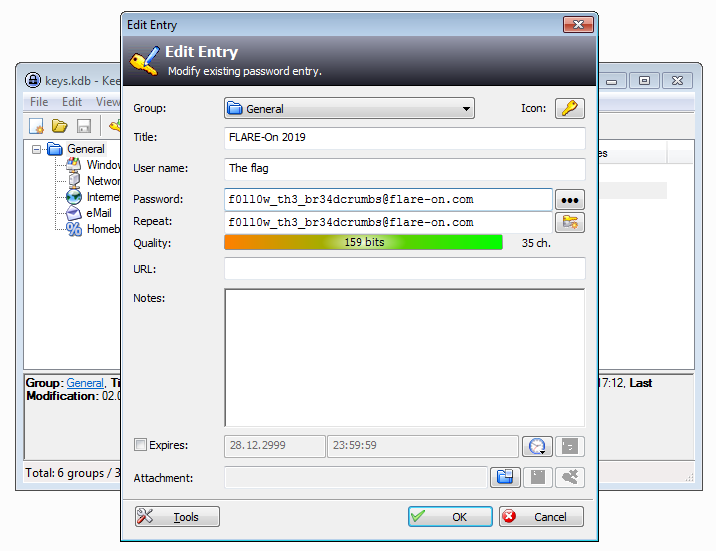
0x0D —
, . , , . , volatility
, . ( UTC+3:00):
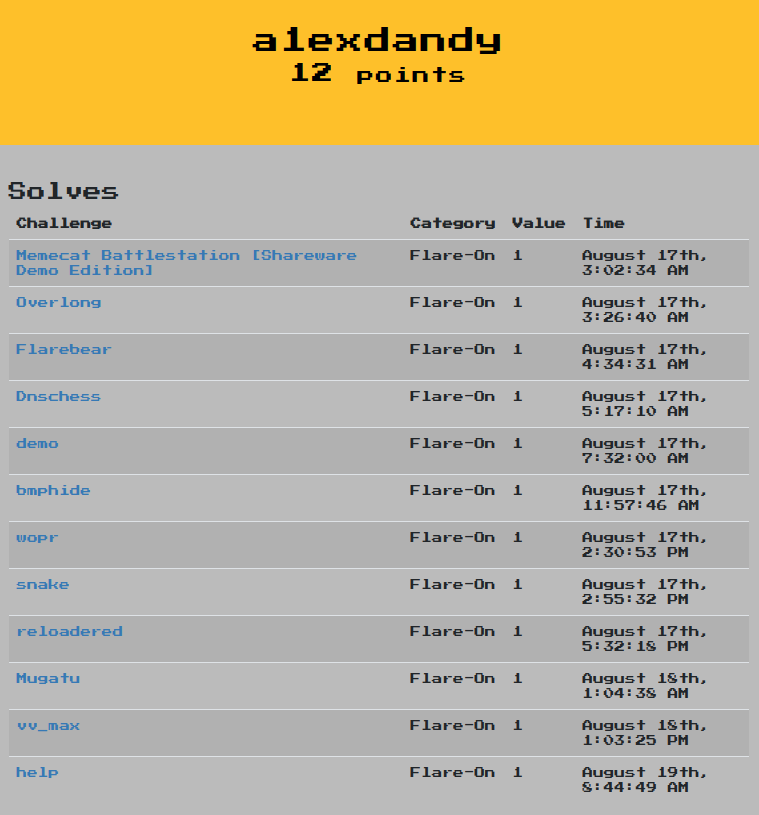
All Articles